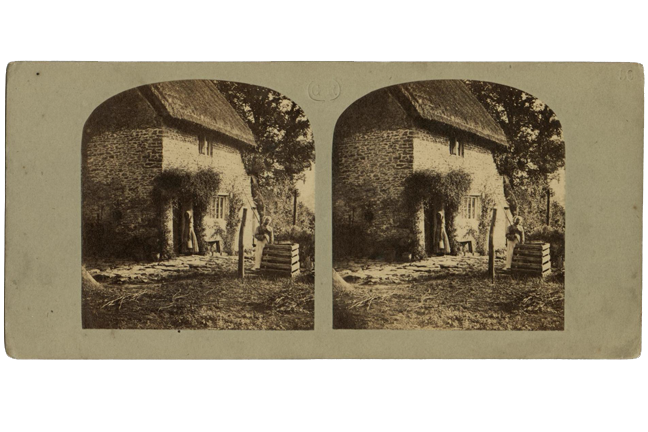Home / Creative Arts & Media / Stereoscopy: An Introduction to Victorian Stereo Photography / Scenes in Our Village
This article is from the free online
Stereoscopy: An Introduction to Victorian Stereo Photography


Reach your personal and professional goals
Unlock access to hundreds of expert online courses and degrees from top universities and educators to gain accredited qualifications and professional CV-building certificates.
Join over 18 million learners to launch, switch or build upon your career, all at your own pace, across a wide range of topic areas.


 Image: Stereocard entitled Scenes In Our Village. / No. / The Straw Yard, by TR Williams 1850-1855. The description on the back of this image reads: ‘Now that at length his harvest work is done, / His straw-yard yielding shelter from the sun / Of summer, and of winter’s frost and snows ; / His shed, his pump, his barrow, and his ground, / The worth of each, how well the farmer knows / And well they harmonize with all around’. IL.2003.44.6.7.80 © Howarth-Loomes Collection at National Museums Scotland
Image: Stereocard entitled Scenes In Our Village. / No. / The Straw Yard, by TR Williams 1850-1855. The description on the back of this image reads: ‘Now that at length his harvest work is done, / His straw-yard yielding shelter from the sun / Of summer, and of winter’s frost and snows ; / His shed, his pump, his barrow, and his ground, / The worth of each, how well the farmer knows / And well they harmonize with all around’. IL.2003.44.6.7.80 © Howarth-Loomes Collection at National Museums Scotland
 Image: Stereocard entitled Scenes In Our Village. / No. / John Sims at His Pigstie, by TR Williams, 1850-1855. The description on the back of this image reads: ‘John with content now views his fattening hog, / Dreams of plump bacon and the Christmas log, / For this with him in truth is dainty fare, / But to complete the feast we add the pomme-de-terr’. IL.2003.44.6.7.75. © Howarth-Loomes Collection at National Museums Scotland
Image: Stereocard entitled Scenes In Our Village. / No. / John Sims at His Pigstie, by TR Williams, 1850-1855. The description on the back of this image reads: ‘John with content now views his fattening hog, / Dreams of plump bacon and the Christmas log, / For this with him in truth is dainty fare, / But to complete the feast we add the pomme-de-terr’. IL.2003.44.6.7.75. © Howarth-Loomes Collection at National Museums Scotland
 Image: Stereocard entitled Scenes In Our Village. / No. / The Cart Shed- Quite Tired, by TR Williams 1850-1855. The description on the back of this image reads: ‘What matters it where, when we’re wearied and worn / With working or walking, awhile we sojourn? / Rest can be found by the peaceful at heart / On a barrow, a truck or the shaft of a cart’. IL.2003.44.6.7.87 © Howarth-Loomes Collection at National Museums Scotland
Image: Stereocard entitled Scenes In Our Village. / No. / The Cart Shed- Quite Tired, by TR Williams 1850-1855. The description on the back of this image reads: ‘What matters it where, when we’re wearied and worn / With working or walking, awhile we sojourn? / Rest can be found by the peaceful at heart / On a barrow, a truck or the shaft of a cart’. IL.2003.44.6.7.87 © Howarth-Loomes Collection at National Museums Scotland





